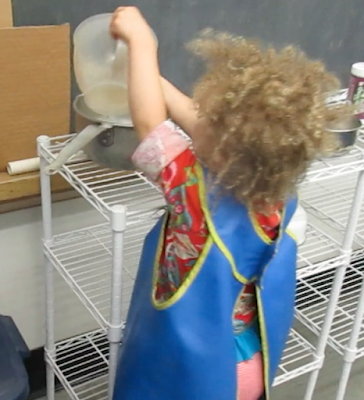For the past several years, I have set up the sensory table as a wash tub for toys that are to be put away for the summer. The original intent was to lighten the staff's work load at the end of the school year. Gradually, as the children took it over, it became something the children did willingly to contribute to the care of the classroom.
At the start of class, I would dump toys that could be immersed in water into the table to be washed and then added water with dish soap. On shelves next to the table, I set out scrub brushes, washrags, bowls and cups for washing the toys. In the picture below, the children were washing a manipulative called Wedgits and long sections of a large muscle toy for balancing.
At the end of class, I asked the children to help rinse the toys in clean water and then set them on towels on a nearby table to dry overnight.
Each new class period, I would dump different toys to be washed. For instance, one day I set out all the "jewels" (glass beads from the craft store) we had been using with the plastacine.
There was quite a bit of plastacine residue on these glass beads so it took a fair amount of scrubbing and fine motor work to get it off. In fact, there was so much residue that I also set the jewels out for the following class.
One of the nice aspects of the toy-washing activity was the friendly chitchat that emerged between the children as they worked. This also turned out to be a great time for the teachers to sidle up next to the table and join in the work and the spontaneous conversations.
Did the toys get clean? Judging from the water that was left in the sensory table, yes. Some of that was due to the fact that the toys simply soaked in soapy water. However, the children's contribution cannot be underestimated. Besides scrubbing and pouring water over the toys, they created natural friction---which contributes to the cleaning process---just by moving the toys in and around the table.
For me as teacher there are at least two important understandings that go along with this activity. The first is that I have to be happy with approximations. What does that mean? That means that I am not looking for perfection only for participation and effort. Too often we judge children's work by adult standards. If I wanted all the toys the children wash to be spotless, the activity would not have to power it does to contribute to the life and caretaking of the classroom, both physically and socially.
The second important understanding is that children do not have the same objective as I do. I want the toys clean. The children want to play. That means that while they are ostensibly cleaning, they are really doing something else. For instance, look at the picture below. We were washing the Duplo train tracks. This child decided to put the "clean" tracks together next to the sensory table.
If I only focused on washing the toys and having the children wash the toys, I might have stopped his building the minute it began. Instead, my decision to what I saw as a provocation on his part was to not stop it. Were the tracks going to get dirty again? Not so much. Could other children still wash toys if they wanted? Yes.
Or here is a picture of a child who was a little more interested in filling a pot with soapy water on one of the shelves next to the sensory table.
This child's actions really had very little to do with washing the toys. Rather, it was fulfilling her need to transport water from the table to fill her pot. Again, my agenda for the activity was different than hers. Is my agenda more important than hers?
Let me try to explain it a different way. Recently I have been telling people about a realization that I have come to when taking care of my grandson. I realized that going to the park with him was not so much about the end goal of getting to the park. The important part was the journey. It was the stick he found that he had to pick up and which he used to hit a telephone pole. It was the snow he then discovered at the bottom of the pole that needed to be smooshed down. It was grate that needed to be examined on the curb of the sidewalk What I am saying is that the time between leaving the house and getting to the park was as rich as anything we did at the park. If I was only focused on getting to the park, I would miss the riches in between. And if I thought getting to the park simply meant using the equipment at the park, I was terribly mistaken. The pound was frozen at the park so we looked for sticks and rocks to toss onto the frozen pond. We wanted to see if the ice would break or not. In fact on this particular day, the equipment was the least important feature of the park. It was almost like another journey began once we got to the park.
Getting back to washing the toys, did I want the toys clean? Yes. But that was my agenda. If my intention was to bring the children into the activity, I had leave room for them to create their own agenda along the way. If I did that, it was a win-win proposition.









